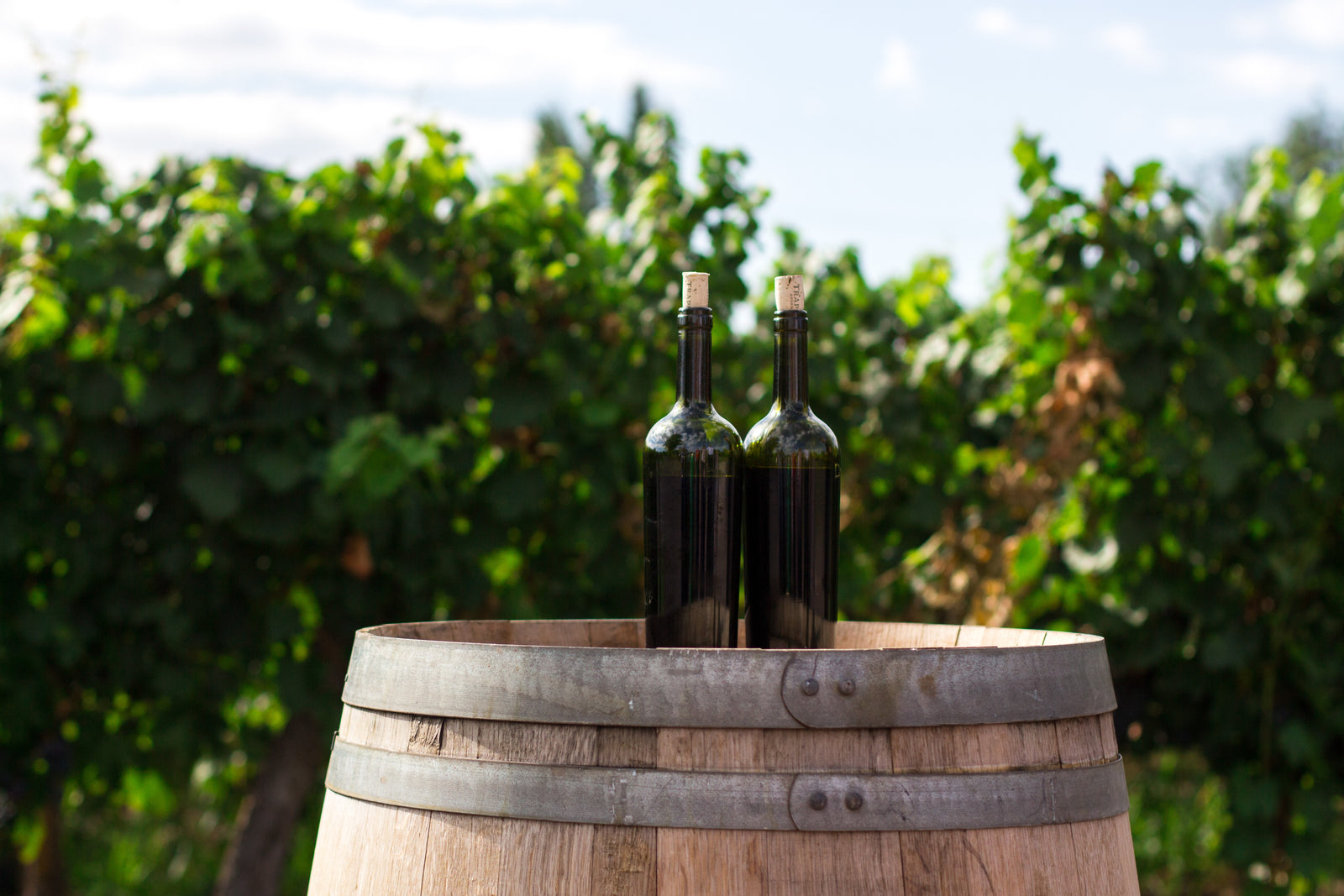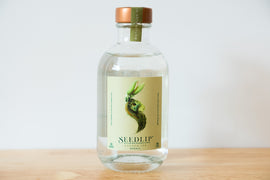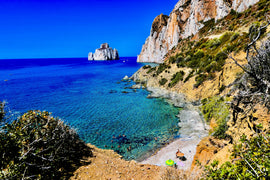It takes a special kind of person to want to make wine. Loving wine itself is not enough. You must love the science behind the art. Winemaking is often described as a delicate balance of art and science. Most wine drinkers already know the general process: the grapes are grown, harvested, fermented, aged, bottled, and then finally consumed, but there are a lot of key decisions that a winemaker needs to make based on each particular vintage and the desired style of the finished product. In the end, what we as consumers hope for is a finished product that showcases a wine’s distinct sense of individuality, authenticity and place. One that stimulates our organoleptic senses, and leaves us with a lasting impression of deliciousness. It’s a tremendous burden a winemaker takes on, but what a thrill it is when wines, like our selections this month, hit the nail right on the head!
Atalier A Cruz das Ánimas Albariño
Occupying the northwest corner of Spain, the province of Galicia is nestled snugly between various mountain ranges to the east, the Atlantic Ocean to the north and west, and Portugal to the south. The region has developed in isolation from the rest of Spain, sharing more similarities, both geographically and culturally, to Northern Portugal, than to the rest of Spain. Considered the wettest region in Spain, Galicia contains five D.O. wine regions: Rías Baixas, Ribeiro, Valdeorras, Monterrei and Ribeira Sacra. Although the climate of Galicia is warm and wet along the coast, it becomes drier as the landscape changes traveling inland. The Galician climate’s great diversity can be explained by the prevailing maritime and continental winds over this part of the world, and also its topography, where a series of N to S mountainous chains check rain-bearing fronts from the Atlantic. Rías Baixas (ree-ahs-buy-shuss), the only exclusively white wine DO in Spain, is considered the most important D.O. in the Galicia region. The D.O. was formally established in 1988 and owes its acclaim to the white Albariño (al-ba-ree-nyo) grape. The term Rías Baixas refers to the lower estuaries – deep, wide inlets of water encroaching many miles inland from the Atlantic Ocean. One might mistake the area for Ireland because of its lush terrain and cool, damp climate, but like the rest of Spain, the region also receives ample sunshine – over 2,200 hours per year. There are approximately 9,138 acres under vine in Rías Baixas, with more than 6,618 growers, and almost 20,000 individual vineyard plots. Rías Baixas is comprised of five subzones with varying terroir: Val do Salnés, Condado do Tea, O Rosal, Ribeira do Ulla, and Soutomaior. There are differences in microclimates, terroir, and grape varieties in the five sub-zones, as well as different winemaking techniques. Val do Salnés is the oldest, largest, and most productive subzone of Rías Baixas, where vineyards with granitic soils hug the Atlantic coastline, and temperatures average 55º F. Within the subzone is the city of Cambados, known as the Capital of Albariño, and home to the Fiesta del Albariño, which has been ongoing since 1953. There are 12 permitted grape varieties but Albariño accounts for 96% of plantings in the region. Albariño was once thought to be distantly related to Riesling, but some enologists now believe that Albariño may be more closely connected to the Petit Manseng variety of southwest France, just on the other side of the Pyrenees Mountains.
Raúl Perez is one of the superstars of modern Spanish wine, with consultancies and projects all over the country. He is a tireless entrepreneur who began his career producing wine in the early 1990s working with masters of the Mencía grape variety at his family’s winery, Castro Ventosa, in his native Bierzo. In recent years, he has embarked on his own projects in Bierzo, Monterrei, Rías Baixas and Ribeira Sacra. Atalier is Raúl’s exciting new Rías Baixas Albariño project. It is produced in conjunction with his friend and frequent collaborator Rodri Méndez (the unofficial conservationist-in-chief of the Salnés Valley) of the Forjas del Salnés estate in the Val do Salnés subzone. Rodri is responsible for scouting the vineyards and establishing agreements with the owners, whom he has known all his life. He remains almost religiously committed to seeking out, recuperating and preserving historic sites such as the ones that go into Atalier’s A Cruz das Ánimas (“The Crossroads of Souls”) Albariño.
Pre-phylloxera, super old vines are the life force of Atalier’s A Cruz das Ánimas Albariño. The grapes come from three dedicated Atlantic coastal sites in the Cambados area of the Salnés Valley. Instead of vinifying in stainless-steel tanks, resulting in wines that are fresh and fruity with zippy acidity, A Cruz das Ánimas is processed the old way – picking later so that the grapes are lower in malic acidity, and slow vinification in large old oak barrels, called foudres, which give the wine much more complexity, textures, and aromas. The oxygenation that occurs during this élevage gives the wine a softer, rounder entry that balances the razor-sharp acids that might otherwise render the wine shrill.
Atalier’s 2017 A Cruz das Ánimas Albariño shows the saline and bright, acid forward qualities of the grape when grown in Rias Baixas, but also the rich, satisfying textural elements from Raul's expressive winemaking. This wine is excellent on its own as an apéritif, with all seafood, tapas, or with main dishes made with veal, chicken, ham, medium-bodied cheeses, or vegetables. Traditional Galician dishes such as Almejas a la marinera-clams steamed with a bit of Albariño, some olive oil and some diced onion, Pulpo a la Gallega (Galician octopus)-a very spicy dish where the octopus is cooked with paprika, or Caldeirada (Galician fish stew)-made with potatoes and a white fish, are incredibly delicious when paired with this Albariño.
Atalier’s 2017 A Cruz das Ánimas Albariño is $25.00/bottle, $270.00/case.
Vina Estampa "Gold" Carménère
Chile is famously long and thin, approximately 3,000 miles in length, from the Atacama Desert in the North, to the glaciers of Patagonia in the South. Spanish settlers brought vines to Chile's Central Valley around 1554, and today the valley is planted with over 277,000 acres of vines. The 625-mile long Central Valley is a plateau between the Andes, rising to over 19,685 ft. in the east, and the low coastal range, with elevations up to 2,625 ft., in the west. With natural boundaries on all sides, the vineyards of Chile are sufficiently isolated to have escaped the late 19th century scourge of phylloxera. Known as a winemaker's paradise, Chile has perfect climate for growing vines; abundant water from melting snow and a virtually pest and disease-free environment. The climate is very hot and dry in the north, and colder and wetter in the south. The proximity to the Andes creates a huge variation between daytime and nighttime temperatures, which is vital for the acidity levels of grapes. The main wine regions of Chile are classified by the various rivers carrying torrents of melted snow across the Central Valley. From north to south they are: Elqui Valley, Limarí Valley, Aconcagua Valley, Maipo Valley, Casablanca Valley, San Antiono Valley, Rapel/Cachapoal Valley, Rapel/Colchagua Valley, Curicó Valley, Maule Valley, Itata Valley, and Bío Bío Valley.
The first evidence of winegrowing and winemaking in the Colchagua Valley comes from the time of the Spanish Conquest of America (1542). In the coastal zone of the Colchagua Valley the Jesuits built their first monasteries and planted the first vineyards to make sacramental wine for celebrating mass. The zone’s climatic and geographic features combine to create a unique microclimate that is ideal for the production of different varieties—Cabernet Sauvignon, Merlot, Carménère, Malbec, and Syrah, just to name a few—and this is reflected today in the high quality of its wines.
From its beginning in 2001, Estampa Winery has focused on innovation and modern techniques to create world-class wines that would fully express the characteristics of the different varieties of the Colchagua Valley. Estampa is the only winery in Chile that specializes in the production of blends, carefully combining two or more varietals to create wines with balance and unique personality. Viña Estampa owns more than 400 hectares of drip-irrigated vineyards in three locations within the Colchagua Valley—Palmilla, Paredones, and Marchigüe. Each has a particular terroir that lends unique characteristics to their wines.
Estampa’s “Gold” is a Carménère-based red blend consisting of 85% Carménère, 10% Cabernet Sauvignon, 3% Petit Verdot, and 2% Cabernet Franc. The fruit comes from the Marchigüe Vineyards located 32 km from the sea. The soils vary greatly within the different sectors of the vineyard, and there are areas with a higher presence of granite, angular stones in process of mineralization, and quartz, as well as red granite with a high amount of iron. The grapes for the “Gold” are picked from a selection of specific blocks with low production per hectare, thus there is greater concentration in the fruit. The different varieties were vinified separately in stainless steel tanks, and once malolactic fermentation is completed, the wine is racked to barrels and aged at controlled temperatures for 14 months in French oak barrels, 35% 1st use, 65% 2nd and 3rd use. In 2015, 1,660 cases were produced.
The 2015 Estampa “Gold” offers a spectacular combination of concentration and smoothness. Sweet, spicy aromas of tobacco, ripe red fruits, plums, notes of truffle and blackcurrant in the nose give way to a silk-textured palate with delicious flavors with notes of red currant, raspberry jam, violet and a hint of eucalyptus. Soft tannins and balanced acidity elegantly support the layered aromatics. Try the Carménère with smoked, grilled or roasted meats, chicken, pork, lamb, beef and veal. It also holds up with, and matches perfectly with, some spicy dishes and strong, hard cheeses.
The 2015 Vina Estampa “Gold” Carménère is $26.00/bottle, $280.80/case.





